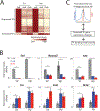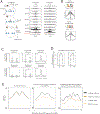An Activity-Mediated Transition in Transcription in Early Postnatal Neurons
- PMID: 32589877
- PMCID: PMC7486250
- DOI: 10.1016/j.neuron.2020.06.008
An Activity-Mediated Transition in Transcription in Early Postnatal Neurons
Abstract
The maturation of the mammalian brain occurs after birth, and this stage of neuronal development is frequently impaired in neurological disorders, such as autism and schizophrenia. However, the mechanisms that regulate postnatal brain maturation are poorly defined. By purifying neuronal subpopulations across brain development in mice, we identify a postnatal switch in the transcriptional regulatory circuits that operates in the maturing mammalian brain. We show that this developmental transition includes the formation of hundreds of cell-type-specific neuronal enhancers that appear to be modulated by neuronal activity. Once selected, these enhancers are active throughout adulthood, suggesting that their formation in early life shapes neuronal identity and regulates mature brain function.
Copyright © 2020 Elsevier Inc. All rights reserved.
Conflict of interest statement
Declaration of Interests The authors declare no competing interests.
Figures







Comment in
-
'Enhancing' brain maturation.Nat Rev Neurosci. 2020 Sep;21(9):450-451. doi: 10.1038/s41583-020-0352-9. Nat Rev Neurosci. 2020. PMID: 32678311 No abstract available.
Similar articles
-
Pet-1 Switches Transcriptional Targets Postnatally to Regulate Maturation of Serotonin Neuron Excitability.J Neurosci. 2016 Feb 3;36(5):1758-74. doi: 10.1523/JNEUROSCI.3798-15.2016. J Neurosci. 2016. PMID: 26843655 Free PMC article.
-
Integrative Single-Cell Transcriptomics Reveals Molecular Networks Defining Neuronal Maturation During Postnatal Neurogenesis.Cereb Cortex. 2017 Mar 1;27(3):2064-2077. doi: 10.1093/cercor/bhw040. Cereb Cortex. 2017. PMID: 26989163 Free PMC article.
-
Neurobiological functions of transcriptional enhancers.Nat Neurosci. 2020 Jan;23(1):5-14. doi: 10.1038/s41593-019-0538-5. Epub 2019 Nov 18. Nat Neurosci. 2020. PMID: 31740812 Free PMC article. Review.
-
Regulation of Adult Neurogenesis in Mammalian Brain.Int J Mol Sci. 2020 Jul 9;21(14):4869. doi: 10.3390/ijms21144869. Int J Mol Sci. 2020. PMID: 32660154 Free PMC article. Review.
-
Temporally divergent regulatory mechanisms govern neuronal diversification and maturation in the mouse and marmoset neocortex.Nat Neurosci. 2022 Aug;25(8):1049-1058. doi: 10.1038/s41593-022-01123-4. Epub 2022 Aug 1. Nat Neurosci. 2022. PMID: 35915179 Free PMC article.
Cited by
-
Interaction of methyl-CpG-binding protein 2 (MeCP2) with distinct enhancers in the mouse cortex.Nat Neurosci. 2025 Jan;28(1):62-71. doi: 10.1038/s41593-024-01808-y. Epub 2024 Nov 22. Nat Neurosci. 2025. PMID: 39578572
-
Distinct epigenetic modulation of differentially expressed genes in the adult mouse brain following prenatal exposure to low-dose bisphenol A.Cell Biol Toxicol. 2024 May 22;40(1):37. doi: 10.1007/s10565-024-09875-4. Cell Biol Toxicol. 2024. PMID: 38777957 Free PMC article.
-
Emerging Insights into the Distinctive Neuronal Methylome.Trends Genet. 2020 Nov;36(11):816-832. doi: 10.1016/j.tig.2020.07.009. Epub 2020 Aug 21. Trends Genet. 2020. PMID: 32839016 Free PMC article. Review.
-
Reorganization of postmitotic neuronal chromatin accessibility for maturation of serotonergic identity.Elife. 2022 Apr 26;11:e75970. doi: 10.7554/eLife.75970. Elife. 2022. PMID: 35471146 Free PMC article.
-
Epigenetic and Transcriptional Regulation of Spontaneous and Sensory Activity Dependent Programs During Neuronal Circuit Development.Front Neural Circuits. 2022 May 18;16:911023. doi: 10.3389/fncir.2022.911023. eCollection 2022. Front Neural Circuits. 2022. PMID: 35664458 Free PMC article. Review.
References
Publication types
MeSH terms
Grants and funding
LinkOut - more resources
Full Text Sources
Molecular Biology Databases

